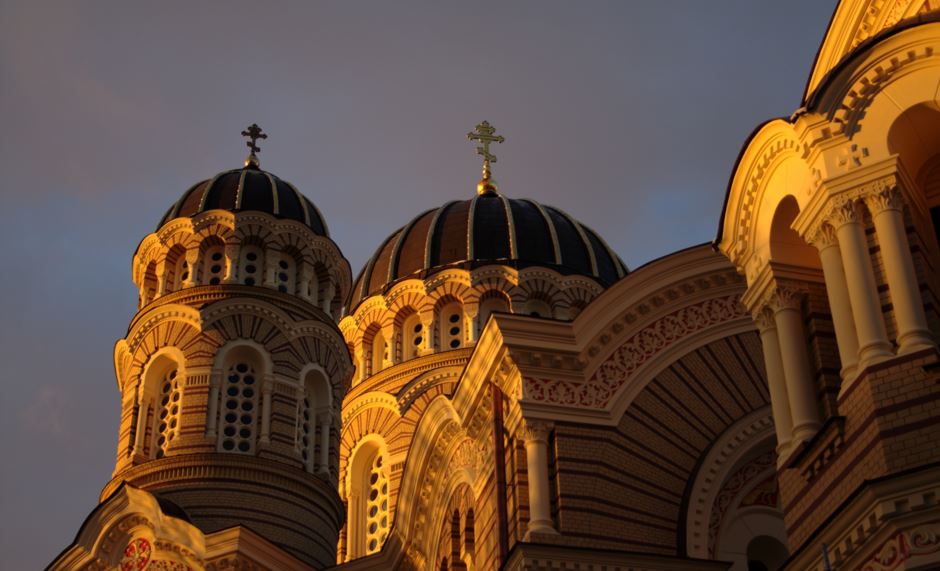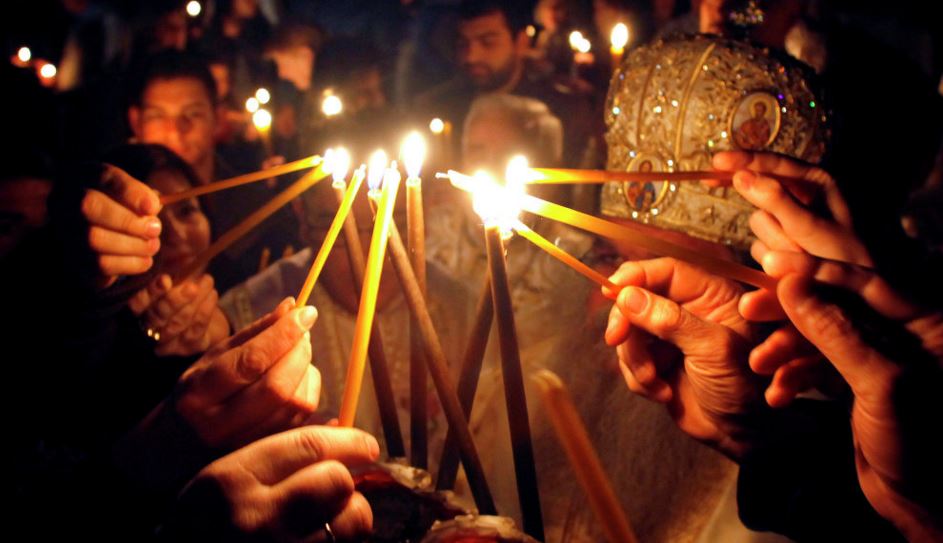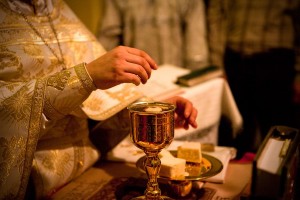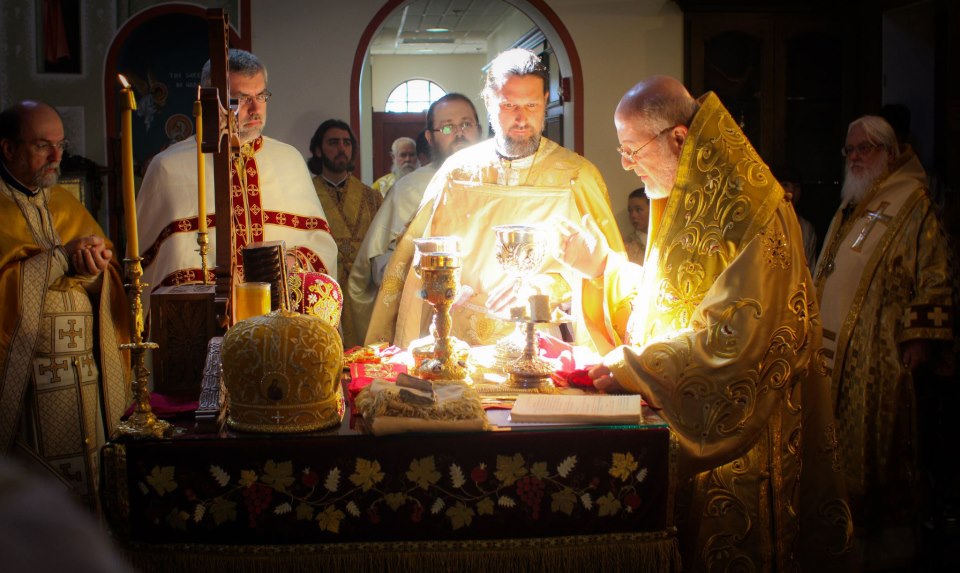A Protestant Visits the Orthodox Resurrection Service
By Brad Jersak
I shall never forget the beauty, wonder and spiritual culture shock the first time I experienced an Orthodox Resurrection service. It was 2006 and my new friend, Archbishop (ret.) Lazar had invited me to join their parish for the midnight service, the traditional Paschal liturgy, proclaiming and celebrating Christ’s victorious death and resurrection. At the time, I was a self-professed charismatic evangelical, ‘my antennas were up,’ hoping to discern the movement of the Holy Spirit in the midst of this other world—rites and rituals that I might have otherwise mistaken for religiosity. But by being attentive, what I underwent bears some theological reflection for the reader’s spiritual edification.

A pre-service ‘Matins’ starts at 11:00 pm with readings from Messianic Psalms preparing us for the service proper. As I entered, I was surprised by the variety of simultaneous activities: priests and deacons were in the altar area, moving around with candles, incense and chanting quietly around the table. Readers on the right were singing songs and reading the Psalms. A line up had formed on the left, waiting to confess to Bishop Varlaam, a St. Nicholas-type spiritual father who exudes the mercy of God. Children in pajamas scurried about, kissing icons and lighting candles. Folks of all types were crossing themselves or doing ‘prostrations’ at various points. It was more than I could take in—so sensual with the many lights, colours and smells. Incredibly tactile—I feel the smooth texture of the long thin candles that are being distributed to everyone, roll it under my nose to inhale the beeswax.
Then at the stroke of midnight, a bell rings and all the lights are extinguished except for those of the clergy, who begin to chant three times with increasing volume:
Thy Resurrection, O Christ Savior, the angels in the heavens sing;
enable us on earth to glorify Thee in purity of heart!
The priest emerges from the altar with a huge candle, wearing royal robes and a diadem. In this liturgical passion play—the drama of redemption—he is playing the part of Christ. He sings,
The Light shines in the darkness and the darkness is not overcome. Come ye and receive the light.
And with that someone lights their candle from his, then passes it on. Gradually, as candle lights candle, the whole sanctuary is illuminated and radiates the truth that in us, the glory of the Lord spreads from sea to sea and across the globe.

I fall into procession as the priest leads us out of the building. Bear in mind, I have no idea what’s coming next. We all join in the song as we walk slowly,
Thy Resurrection, O Christ Savior, the angels in the heavens sing;
enable us on earth to glorify Thee in purity of heart.
As we circumnavigate the church, my candle gives way to the wind or my stumbling, but others quickly relight it. I note how this is not unlike my faith journey at times through this present darkness. Finally, after circling the temple three times, the priest stands before the front doors. He reads a gospel text that announces the discovery of the empty tomb.
He pounds on the door three times and cries out,
Lift up your gates, O ye princes;
and be ye lifted up, ye everlasting gates,
and the King of Glory shall enter in.
Someone behind the closed doors responds,
Who is this King of Glory?
And the priest replies, with boldness,
The Lord strong and mighty, the Lord, mighty in war.
Lift up your gates, O ye princes; and be ye lifted up, ye everlasting gates,
and the King of Glory shall enter in.
Again, from inside,
Who is this King of Glory?
And the priest, loudly,
The Lord of hosts, He is the King of Glory.
Again he pounds on the door and the dialogue is repeated. There are layers to this engagement. One way to see it is Christ entering his temple; but more poignant to the moment is that he is confronting the princes (Hades and Satan), shattering the gates of hades and binding the strongman to plunder his goods. Christ enters death, by death, to overcome death for us all.
The doors swing open and the congregation streams into the church with our candles. Once we are all in, a chant begins—repeatedly and rising in intensity:
Christ is risen from the dead, trampling down death by death,
And upon those in the tombs bestowing life.
These words of victory rise as a ringing refrain that will be repeated again and again throughout the next three hours. This is the central confession of the Eastern Church: The divine Word and second person of the Trinity assumes human nature in the one Person, Jesus Christ, and suffers death to vanquish death. Gustaf Aulen would later refer to this as an atonement theory he called Christus Victor. The Orthodox faithful would raise an objection or two to that designation.

First, Christ’s victory over Satan, sin and death by his death and resurrection is not an atonement theory. It is the gospel proclaimed in the New Testament. It is no theory that Christ defeated death and rose from the grave in power: it is the faith once delivered by Christ to the apostles that we proclaim.
Second, Orthodoxy certainly does speak in terms of victory. But let no one imagine this victory in terms of a dualistic cosmology that takes two competing sides deep into extra time. In Canada, we would call this a ‘trouncing.’ Throughout the Paschal liturgy, we hear the ancient and triumphant theology of the same fathers who gave us our New Testament and Creeds,
Let God arise and let His enemies be scattered,
and let them that hate Him flee from before His face.
Christ is risen from the dead, trampling down death by death,
and upon those in the tombs bestowing life.
As smoke vanishes, so let them vanish, as wax melts before the fire.
And so the liturgy continues, deep into the night. In that setting, only a few chairs lined the walls for the aged and infirm … the rest of us stood for hours on end. My legs were sore, my eyes were tired and a newcomer might be excused if the wonder of the first hour was fading into what seemed like the tedium of repetitive litanies. All of this took longer because parts of the liturgy were repeated in English, Greek, Slavonic and other European tongues.
On the upside, I would regularly be jarred back to attention whenever the priest would nearly shout,
“Christ is risen!”
and the congregation would burst out,
“Truly he is risen!”
Some of the men would even lunge forward onto their front foot, shouting emphatically each time. And I repented for simply assuming that liturgy is always ‘dead’ and those who practice it do so mindlessly.
Eventually, we came to my favourite moment in the service: the Paschal homily of St John Chrysostom (‘Silver Tongue,’ referring to his anointed preaching). In fact, this sermon was considered so authoritative that the Eastern Church chose to preach it verbatim every Pascha as part of the liturgy until the Lord returns. It’s only four paragraphs, riffing off the parable of the day-workers (Matt. 20:1-16) to welcome all to the Feast, and proclaiming again Christ’s descent into hades and the utter defeat of death. It’s worthy of recording here in its entirety:
If any man be devout and love God, let him enjoy this fair and radiant triumphal feast. If any man be a wise servant, let him rejoicing enter into the joy of his Lord. If any have labored long in fasting, let him now receive his recompense. If any have wrought from the first hour, let him today receive his just reward. If any have come at the third hour, let him with thankfulness keep the feast. If any have arrived at the sixth hour, let him have no misgivings; because he shall in nowise be deprived thereof. If any have delayed until the ninth hour, let him draw near, fearing nothing. If any have tarried even until the eleventh hour, let him, also, be not alarmed at his tardiness; for the Lord, who is jealous of his honor, will accept the last even as the first; he gives rest unto him who comes at the eleventh hour, even as unto him who has wrought from the first hour.
And he shows mercy upon the last, and cares for the first; and to the one he gives, and upon the other he bestows gifts. And he both accepts the deeds, and welcomes the intention, and honors the acts and praises the offering. Wherefore, enter you all into the joy of your Lord; and receive your reward, both the first, and likewise the second. You rich and poor together, hold high festival. You sober and you heedless, honor the day. Rejoice today, both you who have fasted and you who have disregarded the fast. The table is full-laden; feast ye all sumptuously. The calf is fatted; let no one go hungry away.
Enjoy ye all the feast of faith: Receive ye all the riches of loving-kindness. let no one bewail his poverty, for the universal kingdom has been revealed. Let no one weep for his iniquities, for pardon has shown forth from the grave. Let no one fear death, for the Savior’s death has set us free.
He that was held prisoner of it has annihilated it. By descending into Hades, He made Hades captive. He embittered it when it tasted of His flesh. And Isaiah, foretelling this, did cry: Hades, said he, was embittered, when it encountered Thee in the lower regions. It was embittered, for it was abolished. It was embittered, for it was mocked. It was embittered, for it was slain. It was embittered, for it was overthrown. It was embittered, for it was fettered in chains. It took a body, and met God face to face. It took earth, and encountered Heaven. It took that which was seen, and fell upon the unseen.
O Death, where is your sting? O Hell, where is your victory? Christ is risen, and you are overthrown. Christ is risen, and the demons are fallen. Christ is risen, and the angels rejoice. Christ is risen, and life reigns. Christ is risen, and not one dead remains in the grave. For Christ, being risen from the dead, is become the first fruits of those who have fallen asleep. To Him be glory and dominion unto ages of ages. Amen.
The first time I heard that homily, given the venue and the build-up towards it, I was transfixed, transported … I … we had come
… to Mount Zion, to the city of the living God, the heavenly Jerusalem, and to myriads of angels, to the general assembly and church of the firstborn who are enrolled in heaven, and to God, the Judge of all, and to the spirits of the righteous made perfect, and to Jesus, the mediator of a new covenant, and to the sprinkled blood, which speaks better than the blood of Abel (Heb. 12:22-24).
 After this, the liturgy led us toward its true climax: the Eucharist. I could have been offended at not being invited to partake (with Chrysostom’s inclusive words still ringing in my ears), the Lord spoke to me and said,
After this, the liturgy led us toward its true climax: the Eucharist. I could have been offended at not being invited to partake (with Chrysostom’s inclusive words still ringing in my ears), the Lord spoke to me and said,
“You have participated to this point; now be a respectful observer.”
It would be another decade before I could wholeheartedly join in their confession,
I believe, O Lord, and I confess that Thou art truly the Christ, the Son of the Living God, who came into the world to save sinners, of whom I am the first.
I believe also that this is truly Thine own most pure Body, and that this is truly Thine own most precious Blood. Therefore I pray Thee: Have mercy upon me and forgive me my transgressions, committed in word and deed, whether consciously or unconsciously. And make me worthy to partake without condemnation of Thy most pure Mysteries, for the remission of sins and unto life everlasting.
Of Thy Mystical Supper, O Son of God, accept me today as a communicant. For I will not speak of Thy Mystery to Thine enemies, neither like Judas will I give Thee a kiss; but like the thief will I confess Thee: “Remember me, O Lord, in Thy Kingdom. “May the communion of Thy Holy Mysteries be neither to my judgment, nor to my condemnation, 0 Lord, but to the healing of soul and body.
As the Orthodox believers lined up to receive it, arms crossed over their hearts, they would turn to the congregation and say,
“Forgive me brothers, forgive me sisters.”
Those near the front would reply,
“God forgives,”
while the rest would sing,
“Receive the body of Christ, taste of the fountain of immortality.”
Happily, at this point, Bishop Varlaam came and grabbed me by the arm. He led me to the line where any and all may receive the blessed bread, cut from the same loaf as Eucharist bread (many congregations also have wine available). That felt better … and then he insisted that I stay for the love feast. Indeed, he seated me as a guest of honour at the clergy table next to the Archbishop.
Yes, an agape feast, signifying the Marriage Supper of the Lamb (with actual lamb and mint sauce and red wine and plumb brandy and a dizzying multi-cultural banquet to break the fast ):
On this mountain the LORD Almighty will prepare a feast of rich food for all peoples, a banquet of aged wine—the best of meats and the finest of wines (Isa. 25:6).
But wait, you should interrupt, if you’re keeping track. A banquet at 3:30 am? Absolutely. With children? Not just awake, but truly wired! In one case, by sunrise of Resurrection morning, the congregation had spilled out into the church parking lot where a lamb was roasting on a spit, and the priest shared cans of Guinness and smoked pipes with his joyful friends. As I said, spiritual culture-shock …
Eventually I would be chrismated by Archbishop Lazar and was later ordained ‘Reader Irenaeus’ by Archbishop Irenée. While the Orthodox Church may not be every believer’s cup of tea, I believe it has something to offer the rest of the Body of Christ, particularly in its stewardship of the faith of the great Fathers and Mothers of the Church, and in its emphasis on Jesus Christ as the revelation of
“a good and merciful God, who loves humankind.”
Even for those who are not called to that stream of Christianity, I hope this reflection on the Orthodox Pascha will build another little bridge upon which we might extend our embrace to a much wider Christian world.
And if you get the opportunity, please do visit the Liturgy of the Resurrection at least once in your life. This year it will begin at midnight (Sat. night, April 30 / Sun. morning May. 1).

